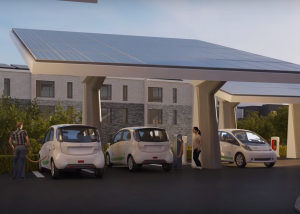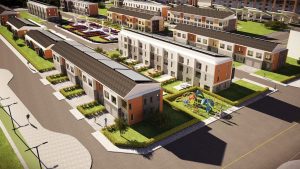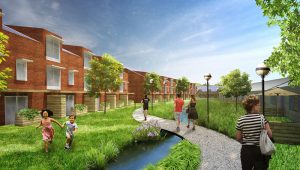
IoT connects Smart City projects
Stephen Law
Automation / Robotics Electronics Regulations & Standards Wireless Engineering IoT IoT IoT Smart Cities Smart citiesSt. Jacobs ON-based s2e Technologies Inc. delivers research and collaboration to establish sustainable solutions development
The multitude of engineering skills combined with the breadth of technologies required to deliver a large scale IoT project can’t be overstated. Clearly difficult to build alone, such detailed endeavors often require research and collaboration for bringing the many elements together. 
This is where s2e Technologies Inc. of St. Jacobs Ontario comes in, a leading Sustainable Solutions Development firm that has managed the development of SMART Community or City projects in Canada. Also specializing in renewable energy solutions and micro-grid projects, s2e Technologies collaborates in large scale IoT initiatives by maximizing the use of state-of-the-art technologies and solutions to support efficient and sustainable growth – including net zero energy and smart grid infrastructure.
Here, EP&T sits down with members of the s2e Technologies team to discuss their approach and involvement with large scale IoT projects in Canada.
Q. Provide our readers with a thumbnail sketch of the part you play in Smart Community projects?
s2e. Before we could build anything resembling a Smart Community, we had to prove that our vision was feasible from a technical and financial standpoint. Towards this end, we undertook an extensive Smart Community feasibility study that considered the possibilities for Net Zero Energy in a large scale real estate project, as well as sustainable concepts around water, waste and urban agriculture. We collaborated with 90 graduate students from 11 Canadian Universities to study the various aspects of what we called “Smart”, and we demonstrated how these communities could be built while also making money. In other words, we proved the potential for an attractive triple bottom line – good for people and the planet, while being profitable. However, we realize that we have a long way to go before these concepts become engrained in the mindset of developers, architects, engineers and even municipalities. Our role is now one in which we partner with developers or build projects on our own to demonstrate a new way of building communities that are desirable to homebuyers and tenants, environmentally friendly, and profitable.
Q. What types of research does s2e Technology deliver when collaborating with its clients?
s2e: Research is always purpose-driven, and guided by the needs of the partners involved. With a grocery store partner, we are researching different refrigeration systems. For office buildings, we’re more interested in ventilation and heat-reclaim systems like VRF (Variable Refrigerant Flow) that enable us to move heat from the sunny side of the building to the shaded side of the building, rather than needing to add heat to one side and add air-conditioning to the other. For homes, we’re researching DC appliances that run more efficiently than traditional AC appliances, and we’re looking at controllers that connect them to DC electricity from solar panels. And for basically any application, we’re looking at how to integrate electric vehicles, energy storage, and control systems that help to optimize utility grid interactions. Our research is diverse and varies by context, but the persistent thread is to identify more sustainable and efficient ways of delivering built environments and transportation systems.

Q. Outline the importance technology plays with existing infrastructure or in planning for the future.
s2e: Technology is an ever-evolving set of tools that can help us to address infrastructure challenges that impact our daily lives. Often when you solve for one challenge, another issue presents itself that needs to be addressed. For example, electric vehicles have utilities everywhere excited right now, but these vehicles can use as much energy as an efficient home. If ten neighbours drive home from work at 6pm every day and all want to charge their vehicle at the same time, the electrical grid is challenged by that load spike and prolonged draw. These cars have tremendous ability to reduce commute related GHG emissions, but present other challenges for the grid and the reliable delivery of power. In planning infrastructure, it is important to understand “where the puck is going, not where it has been”. We work very closely with various levels of government to test and demonstrate new technologies so they can plan for future infrastructure needs with some knowledge of what is coming .
Q. What are often some of the biggest hurdles in achieving sustainability in these type of NZ projects?
s2e: It’s not the technologies – many sustainable building and transportation technologies have proven performance records either in Canada or elsewhere in the world. The biggest hurdle is people – people who are stuck in the status quo. This could be developers who have no incentive to build sustainably in hot real estate markets, or architects who design by the same building standards that just meet code, or overworked building inspectors who see innovation as time-consuming risk to be feared or avoided. However, this is an interesting time, consumers have become much more aware of climate change issues, and are showing some willingness to pay for viable solutions that reduce their footprint.
Q. How do you integrate technology into smart cities? How does it all work together? How do you avoid common pitfalls in developing connected products?
s2e: As mentioned above, technology only gives us tools. It is still up to people to use those tools to solve problems and meet real needs. The human to technology interface is critical to ensure broad acceptance and usability. The most common pitfalls with technology integration happens when it is assumed that the technology will magically solve a human problem, and they forget to talk to end users, or omit necessary steps in planning. It’s almost hubris to say it, but technology is all about planning: “talk early and often”. Smart Cities are all about leveraging advanced technology to address problems that range from simple to highly complex and integrated across multiple platforms. The more complex, the more planning and discussion is required. Planned right, and implemented well, then we see results that start to look like magic:
…like street lights that have focused beam-spreads that flood the street without intruding into adjacent buildings, and that turn on/off by themselves when vehicles drive up or down the street (without disturbing sleeping residents beside them);
…like parking app’s that tell you where the closest available parking space is and at what price, and that let you pay by phone to reserve it; 
…or like utility planning app’s, that can report on the energy use of entire city blocks, helping utility planners to see where electric vehicles are used most, where solar panels are generating most, which buildings are efficient and which are not, where brown-outs are most likely, where system upgrades are needed, … and so much more.
Q. IoT projects are embedded with electronics, software, sensors, actuators and connectivity which enables these objects to connect and exchange data.
Explain the different roles played by hardware systems and software systems in these networks of physical devices.
s2e: IoT is, in many ways, a physical embodiment of ideas that are really not new. Of all the tools that technology can give us, the ones that impress us most are the ones that affect our real-life daily experience, and this is where IoT shines. Some famed examples include things like Amazon buttons, where you can press a button to order more laundry detergent right from your laundry room (billed and shipped in real-time), or a refrigerator that can scan its contents and (1) offer you recipes or meal suggestions or (2) learn which suggestions you like to accept and tailor its recommendations, even suggesting grocery lists of things you’ve run out of for your favourite recipes.
IoT is ultimately a system or concept built from parts, where software is the brain, and hardware is the muscle. Hardware devices (sensors / actuators / electronics) can only do the simple tasks they’ve been programmed to do. Software uses these devices to make magic happen (from ordering laundry detergent to suggesting a customized grocery list). The “Internet of Things” is the communication and exchange of data that happens between these devices, via clever software: where a “thing” in your laundry room can tell a “thing” at the Amazon warehouse that you want to order laundry detergent, which in turn tells another “thing” to bill you, and yet another “thing” to package up the detergent and ship it to you.
Q. s2e Technologies partnered with Sifton Properties Ltd. to create West 5 Project in London ON – the largest SMART community in North America. Describe the complexities and layers of technologies involved in pulling that project together.
s2e: West 5 is an integrated 70 acre community which, when complete, will house over 1600 families and some 450,000 square feet of retail and commercial/office space in a variety of mixed format buildings from town-homes to towers. This means that the design team has had to consider technologies across a variety of building platforms, and the integrations between them. The project’s objective was to provide all of its’ own energy needs (i.e.: net-zero energy at the community level), and to feature a variety of advanced technologies that enable “smart” living. So far we’ve constructed the first office building and the first ~80 townhomes, and three more buildings (including the first 11 storey tower) are under construction now.
Each building presents its’ own challenges, but there have been some themes: the community is intended to generate its’ own power, which means that some buildings will need to make up for the needs of others, by hosting extra solar panels over parking, on facades, or wherever they fit, which has raised a number of creative challenges around installation methods in each case. Some buildings will have EV charging areas where vehicles will be shared among multiple tenants/users, and their availability will be scheduled with smart-phone apps. Street lighting will have smart-controls and motion sensing. There will be Wi-Fi available in major public areas throughout the community. Some of the technology used (like Wi-Fi and insulation) is really not going to feel new or exceptionally “smart”, but the way it is integrated across the site, and the scaled impact it has when implemented at that level, is where the real magic is achieved. Disclaimer: “magic” = “seamless experience for end users” = “headache for engineers”. Once implemented, this “Smart community” will be full of subtle things that users should barely (if ever) notice, and then the complexities that wove that experience together will have been worth the effort.
Q. As a rule, large scale IoT projects require many developers and designers to make happen. And yet, plenty of myths still circulate regarding how IoT engineering is done. Describe some of the key issues involved.
s2e: This is a fun question. How expensive is a car? How warm is a house? Both questions should evoke more questions – what house? What car? Every house and car is different, and the cost or performance of each varies just as widely as IoT applications and development approaches. The truth is that each application of IoT is, by the nature of the mix of “things” involved (which vary widely by application), destined to be unique. But there are some commonalities worth learning from.
Every IoT system is built from the same 4 pillars: (1) sensors/devices, (2) communications, (3) security, and (4) data. IoT lives at the intersection of many disciplines which tend otherwise not to occupy the same space, and each of these four terms means different things to people from the technology, construction, logistics, and material supply industries, so naturally they see each other’s work as a bit of black magic that can create confusion when you combine them all. “Smart community” projects, or really any project that is “smart” in any way, must start with a smart plan: the team must have a detailed discussion about what their strategy will be on all four items above: (1) what devices they will use to collect what data, (2) how that data will be shared across the internet and with whom, (3) how that data will be kept secure, and (4) what information will be processed out of that data, and how that information will be used to create value.
It is a myth that IoT automatically creates value, and it is an equal and opposite myth that IoT is only about data and learning and does not need to create business value. Clever IoT projects are built upon clever uses of meaningful data, applied to solve problems that vary from finding a parking space to ordering more laundry detergent.
Q. Describe the importance IoT plays in the future development of our cities, as well as manufacturing environments.
s2e: When you consider that the average cost of an IoT sensor will be about 40 cents by 2020, and that these sensors will transmit in real time a wide range of data, from the condition of materials in a building after a storm to water quality out of the tap, there is virtually no element of daily city life that can’t be ‘datafied’. Routines will be deciphered and optimized, abnormal conditions identified before they become dangerous, and so on. All the while, new technologies are developed as the data reveals a gap, a need, a better way. While the potential for improving city life is exciting, there are some real questions that cities will need to address as this datafication happens, including who has the privilege of access and how the data providers’ privacy will be protected. IoT alone will not define the great cities of the future. Rather, the pact that a city makes with its citizens about the use of their data may be the defining element of what will be the great cities of the future.
Q. Your firm advocates that innovation, technology and people are sustainable solutions that make a real difference in IoT projects. Describe some other pilot projects and how you anticipate deploying them as an open-source IoT solution.
s2e: Some of our most exciting projects are still confidential, but we are working on a number of initiatives that will touch on IoT. Keeping in mind that technology is a set of tools that help us to solve human problems, some of the problems we’re solving with IoT are being implemented in West 5 in London, ON. We’re looking at Smart Homes, with a modest level of automation options for energy, lighting and home entertainment systems. We’re looking at a DC microgrid, where IoT devices will measure energy flows and report back to a centralized control/monitoring station, where we will log and trend data to assess optimization opportunities as local EV use expands. We’re looking at community level Wi-Fi, with opt-in marketing services integrated. Where willing users can let the system monitor their shopping history and present location in order to change digital signage to welcome them with personalized greetings or targeted coupons which should be of interest to them, email them personalized coupons, or alert them to specials in their favourite local shops. And we’re looking at parking applications, where IoT solutions can help us to empower local drivers to find their way to the parking spaces closest to their intended destination.
Done well, IoT solutions can help users to make choices that reduce travel time, increase sharing of vehicles, increase efficiency of buildings, increase productivity of outings, and ultimately reduce emissions related to any of these things. Our IoT solutions will help enable more sustainable living, while simplifying and enhancing quality of life.
